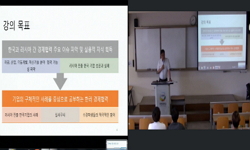지구 온난화에 따른 북극해의 여름철 해빙 농도 감소는 관측을 통해 확인되고 있으며, 특히 북극해 태평양 인접 해역인 척치해는 다른 해역보다 높은 비율로 해빙 농도가 감소되고 있다고 ...
http://chineseinput.net/에서 pinyin(병음)방식으로 중국어를 변환할 수 있습니다.
변환된 중국어를 복사하여 사용하시면 됩니다.
- 中文 을 입력하시려면 zhongwen을 입력하시고 space를누르시면됩니다.
- 北京 을 입력하시려면 beijing을 입력하시고 space를 누르시면 됩니다.
https://www.riss.kr/link?id=T15539636
- 저자
-
발행사항
인천 : 인하대학교 대학원, 2020
-
학위논문사항
학위논문(석사) -- 인하대학교 대학원 일반대학원 , 해양과학생물공학과 , 2020. 2
-
발행연도
2020
-
작성언어
한국어
- 주제어
-
발행국(도시)
인천
-
형태사항
xii, 49 p. 26 cm
-
일반주기명
인하대학교 논문은 저작권에 의해 보호받습니다.
The Change of Circulation and Appearance of the high and low salinity cold waters in the Pacific sector of the Arctic Ocean
지도교수:박재훈
참고문헌: p.44-49 -
UCI식별코드
I804:23009-200000286782
- 소장기관
-
0
상세조회 -
0
다운로드
부가정보
국문 초록 (Abstract)
지구 온난화에 따른 북극해의 여름철 해빙 농도 감소는 관측을 통해 확인되고 있으며, 특히 북극해 태평양 인접 해역인 척치해는 다른 해역보다 높은 비율로 해빙 농도가 감소되고 있다고 알려져 있다. 이에 영향을 미치는 북극해 해수 변동성을 파악하기 위해 쇄빙선 아라온호는 매년 8월 척치해를 포함한 북극해 태평양 인접 해역에서 해양 관측 조사를 수행하고 있다. 본 연구에서는 2012, 2015~2018년까지의 정점 연직 수온·염분 관측 자료를 분석하여 북극해 태평양 인접 해역의 전반적인 수괴를 분류하였다. 연구해역의 수괴는 일반적으로 Melt Water(MW), Pacific Water, Atlantic Water(AW)로 나누어지며, Pacific Water는 세부적으로 Pacific Summer Water(PSW), Remnant Winter Water(RWW), Newly-ventilated Winter Water(NVWW)로 구분된다. 그런데, 2017년부터 기존의 분류에 해당되지 않는 냉수 수괴가 관측되었고, 염분을 기준으로 고염냉수(High Salinity Cold Water, HSCW), 저염냉수(Low Salinity Cold Water, LSCW)라 명명하였다. 두 냉수의 분포와 특징을 확인하기 위하여 Mendeleev 해령 근처인 북위 82°부터 서경 165°까지 L자 모양의 관측 정점 자료를 자세히 분석하였다. 고염냉수는 34~34.5psu의 염분을 가진 수괴로 동북극해 대륙 주변부에 존재하는 유사한 수온과 염분 범위를 가진 저온염분약층(Cold Halocline Water, CHW)으로부터 파생되었을 것이라 생각되며, 2015~2016년까지 Mendeleev 해령 부근 북위 78°보다 높은 곳에서 분포하다 이후 대륙사면을 따라 동남쪽으로 이동한 것을 파악하였다. 저염냉수의 경우 31.6~32.1 psu의 염분을 가지며 빈도수 T-S Diagram을 통해 RWW와 NVWW와는 다른 염분 및 수온 범위에 수괴가 집중되어 있음을 확인하였으며, 2015~2016년에는 존재하지 않다가 2017년 동시베리아해의 대륙붕에서 분포하던 수괴가 연구해역으로 유입된 것으로 보인다. 특히 두 냉수의 유입이 시계 방향의 해수 순환이 이루어졌던 다른 연도와 달리, 바람 방향의 변화로 발생한 반 시계 방향의 순환이 강했던 2017년에 발생하였음을 확인하였다.
다국어 초록 (Multilingual Abstract)
The Arctic Ocean has seen a continuous decrease of its sea ice concentration (SIC) in summer. Especially, the Chukchi Sea, a part of the Pacific Arctic Sector, shows higher decreasing rate than other regions in the Arctic Ocean. To identify the Arctic...
The Arctic Ocean has seen a continuous decrease of its sea ice concentration (SIC) in summer. Especially, the Chukchi Sea, a part of the Pacific Arctic Sector, shows higher decreasing rate than other regions in the Arctic Ocean. To identify the Arctic seawater variability that affects the SIC changes, icebreaker Araon has conducted in-situ observations every August in the region around the Chukchi Sea. This study analyzed the observed temperature and salinity profiles collected in 2012 and 2015 to 2018 to classify the overall mass of waters in the Chukchi Sea. Previous studies divided water masses in the study area into Melt Water (MW), Pacific Water, and Atlantic Water (AW). In addition, Pacific Water was divided into Pacific Summer Water (PSW), Remnant Winter Water (RWW), and Newly-ventilated Winter Water (NVWW). Interestingly, the water properties in 2017 reveal water masses that do not correspond to the traditional classification. The newly found water masses were named High Salinity Cold Water (HSCW) and Low Salinity Cold Water (LSCW) based on their salinity ranges. In order to identify the distribution and characteristics of the two cold waters, temperature and salinity data from near the Mendeleev ridge of 82°N to 165°W were analyzed in detail. The HSCW, ranging between 34 and 34.5 psu, seems to originate from Cold Halocline Water that has similar temperature and salinity ranges and is located around the Northeastern Arctic continent. In 2015–2016, the HSCW was found near the sea surface in a limited region north of 78°N, and then it seems to have moved southeastward along the continental slope in 2017 to occupy at depths of 100–200 m in the southwestern part of the Chukchi Sea. The occurring frequency T-S Diagram confirms that the water properties of LSCW, ranging between 31.6 and 32.1 psu, are different from those of RWW and NVWW. The wind pattern in the Pacific Arctic Sector in 2017 was different from other years, which reversed the oceanic circulation from clockwise to the anti-clockwise. This seems to have caused the appearance of the two cold waters by moving them southwestward from the continental shelf of the Eastern Siberian Sea.
목차 (Table of Contents)
- 1. 서론 1
- 2. 관측 및 자료처리 4
- 2.1 연구 해역 및 자료 획득 4
- 2.2 자료처리 9
- 3. 결과 12
- 1. 서론 1
- 2. 관측 및 자료처리 4
- 2.1 연구 해역 및 자료 획득 4
- 2.2 자료처리 9
- 3. 결과 12
- 3.1 북극해 태평양 인접 해역의 수괴 분류 12
- 3.2 북극해 태평양 인접 해역의 기상 및 해빙 이동 변화 19
- 3.3 북극해 태평양 인접 해역의 수괴 분포 23
- 3.3.1 수직분포도 23
- 3.3.2 수평분포도 26
- 4. 토의 35
- 5. 결론 42
- 6. 참고문헌 44











